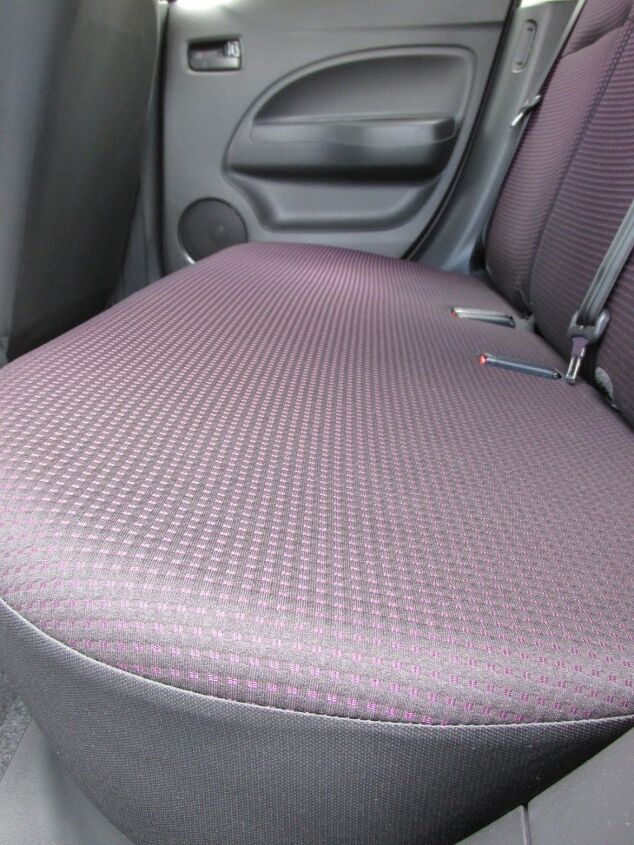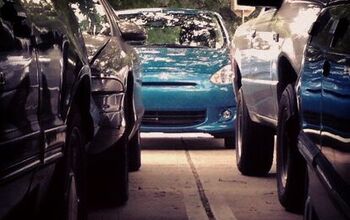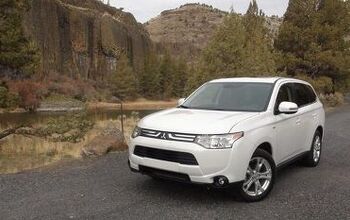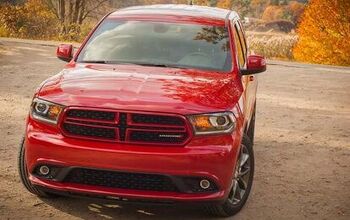Capsule Review: 2014 Mitsubishi Mirage

Deep within the comments of a recent luxury vehicle review, a familiar, satirical exchange takes place:
Googleplex: The pixel-density on the new touch system is passable, but LCD screens in cars in 2014 are laughable. Have these people even heard of AMOLED?
MauraudStar: Panther Love knows no touchscreens, my friend.
MoparMalaise: Panther Love knows no rich Corinthian leather, either.
VivaVega: We lost the war against fuel injection in the 1980’s, and I’m not about to give up the rest of my control to electronic nannies. Spare me your all-wheel drive, your dual-clutch transmissions and the 30 years of weight gain! Why can’t someone build a simple, functional car anymore?
Will any manufacturer answer VivaVega’s question? Enter the 2014 Mitsubishi Mirage.
This isn’t the first time Mitsubishi has sold a subcompact with the Mirage nameplate. The first generation Mirage debuted in 1978. ( You might be more familiar with it as the fourth gen Dodge Colt or Plymouth Champ). Mitsubishi’s fortunes waxed and waned over the next three decades, and the Mirage was eventually discontinued in 2003. The name was revived in 2012, and North American exports started for model year 2014.
So how far have we come since 1978? Generation one was notable mostly for its fuel efficiency and price. Braking was handled by vented discs in the front and drums in the back. Seventy horses were corralled in a 1.4 liter four-cylinder engine. Overall weight ranged from just 1,700 to 1,984 pounds.
Generation six, represented by today’s 2014 specimen, is notable for fuel efficiency and price. Braking is handled by vented discs in the front and drums in the back. Seventy-four horses are corralled up in a 1.2 liter three-cylinder engine. Overall weight is just 1,973 manufacturer-stated pounds.
Wait… what?
Yup. 1,973 pounds in a street-legal 2014 with seven airbags, five seats, four wheels and a compact spare tire. A modern Mirage’s weight and power may be indistinguishable from its groovy forefathers, but the equipment list certainly isn’t – standard features include keyless entry, air conditioning, a 140 watt stereo, and powered windows, locks and mirrors. Not too shabby for $13,805 (DE trim with 5-speed manual at MSRP plus destination).
Most sales volume is expected to come from the ES trim with a CVT. Parting with $16,005 adds fog lights, 14” alloy wheels, Bluetooth connectivity, passive entry and a push-start button that curiously resides to the left of the steering wheel.
How are these prices accomplished? The manufacturing location certainly plays a role. Much hay has been made on TTAC about the viability of Chinese-manufactured cars in North America. Open the Mirage’s hatch ( or eventual trunk in the Canadian market) and take a whiff. That ain’t wasabi, but it ain’t dim sum either. Hope you like Thai!
Most likely, the Mirage is a small start to a large trend. While just 7,200 Mirage’s are forecasted for the US market this year, Thailand is already a major regional automotive exporter. Automotive News pegged Thai automotive production at 2.45 million vehicles in 2012, and over a million were exported. Other nameplates, most notably the Ford Fiesta, will also exported to North American from Thailand over the next few years.
Small export volume certainly helps account for the Mirage’s nondescript, global looks. Styling a vehicle 148.8 inches long and 59 inches tall is tough, but Mitsubishi could have done worse ( the i-Miev comes to mind). The scant grill looks a bit odd, but it does help the Mirage achieve an impressive coefficient of drag – just 0.28. The spectrum of available colors – bright green, blue, red, even a noxious purple – is a welcome change from the white, black and grey Mitsubishi could have certainly made a business case for.
So the exterior is cheap and maybe even a bit cheerful. Does the interior continue the theme? Unfortunately, no. Plastics are hard and drab as expected, but they are also severely straightforward. Unlike the Fiat 500, there is no playfulness or fashion in the design. The experience is aesthetically similar to Korean vehicles designed in the early 2000s. Fit and finish is similar too – a few trim pieces didn’t line up well, and exposed fasteners are easy to find.
Functionality isn’t following form, but it still isn’t flawless. Driver controls are simple, but only one cupholder is available in the rear. The roofline enables decent cargo capacity in the hatch, but the only dome light is up front near the driver. Rear leg room is surprisingly good, but the contourless rear bench forces passengers in back to brace themselves during routine urban maneuvers.
The suspension’s constant body roll can be blamed for some of that. Ride quality was better than anticipated though, and the brakes felt decent. Still, understeer is high, tire grip is low and the electric power steering is poorly implemented. Enthusiasm just isn’t welcome here. Count me out of Derek’s spec-Mirage racing series.
The powertrain never promised fun though, just efficiency. The 1.2 liter three-cylinder engine manages 34 city/42 highway/37 combined with the five-speed manual and 37 city/44 highway/40 combined with the CVT. Mitsubishi claims the Mirage has the best combined non-hybrid efficiency in the US (Ford’s three-cylinder Fiesta scores 32/45/37). The CVT gets clunky around complete stops, but it is mostly helpful on the road. The car is never fast, but it did feel wholly adequate for use around town with occasional interstate jaunts.
Considering the physical dimensions, budget and powertrain, Mitsubishi succeeded in crafting a very efficient, mostly normal driving experience. They deserve applause for that. Unfortunately, they won’t hear it due to the Mirage’s abnormally high noise levels.
I’ll be frank – the Mirage is the loudest passenger car I can remember driving in the last five years. Only jackhammer operators and cross-country motorcycle riders could describe it as “not too bad.” At idle, the engine note varies somewhere between a warble and an unsteady growl. Rumble up to highways speeds, and the turn signals are nearly inaudible. My wife, a decidedly mainstream consumer, felt the noise levels let down the rest of the car.
Vibration will also be problematic for the average Joe. The passenger seat shook at idle, and a constant tingle could be felt through the steering wheel. The three-holer doesn’t generate Peterbilt-grade rumble, but buzz is always present. Like the 2014 Outlander I recently drove, the brand-new Mirage also had a constant interior squeak.
So where does the Mirage stand? The Chevy Spark’s fuel efficiency falls short, but the design is more upbeat. A Nissan Versa is larger and can be configured cheaper, but its warranty is bested by the Mirage’s 10-year guarantee. The used market offers myriad possibilities, but buying new is a point of pride for many consumers.
Many people say they just want something cheap that runs. Consider the 2014 Mitsubishi Mirage their litmus test.

More by Daniel Latini
Latest Car Reviews
Read moreLatest Product Reviews
Read moreRecent Comments
- 1995 SC I will say that year 29 has been a little spendy on my car (Motor Mounts, Injectors and a Supercharger Service since it had to come off for the injectors, ABS Pump and the tool to cycle the valves to bleed the system, Front Calipers, rear pinion seal, transmission service with a new pan that has a drain, a gaggle of capacitors to fix the ride control module and a replacement amplifier for the stereo. Still needs an exhaust manifold gasket. The front end got serviced in year 28. On the plus side blank cassettes are increasingly easy to find so I have a solid collection of 90 minute playlists.
- MaintenanceCosts My own experiences with, well, maintenance costs:Chevy Bolt, ownership from new to 4.5 years, ~$400*Toyota Highlander Hybrid, ownership from 3.5 to 8 years, ~$2400BMW 335i Convertible, ownership from 11.5 to 13 years, ~$1200Acura Legend, ownership from 20 to 29 years, ~$11,500***Includes a new 12V battery and a set of wiper blades. In fairness, bigger bills for coolant and tire replacement are coming in year 5.**Includes replacement of all rubber parts, rebuild of entire suspension and steering system, and conversion of car to OEM 16" wheel set, among other things
- Jeff Tesla should not be allowed to call its system Full Self-Driving. Very dangerous and misleading.
- Slavuta America, the evil totalitarian police state
- Steve Biro I have news for everybody: I don't blame any of you for worrying about the "gummint" monitoring you... but you should be far more concerned about private industry doing the same thing.






































Comments
Join the conversation
Talk about a dollar store interior. This car has that in spades even right down to the floppy 4" piece of cable that provides a USB port hidden in the glove box. The road noise is easy to explain. The doors are about 1" thick leaving no place to even put insulation. I'm sure the floor boards and fire wall have no insulation either. I'll take the 1-2 year old Cruze Eco please for about the same coin and highway MPG.
Dealership near me is selling new Mirage DE with CVT for $12,700. EPA combined of 40 mpg Using Cars.com, the best used Hyundai Accent with automatic I can find for $13,000 are 2012 Accent GLS with 25,000 - 35,000 miles. EPA combined of 31 mpg. The used Sonatas in the $12-$13 k are 2010's. EPA combined of 25 mpg. Hyundai powertrain warranties are not transferrable either. The Elio is what I'm waiting for, but if that does not happen, something like the Mirage is my next option.